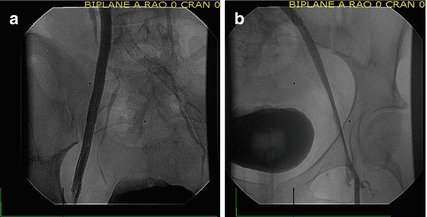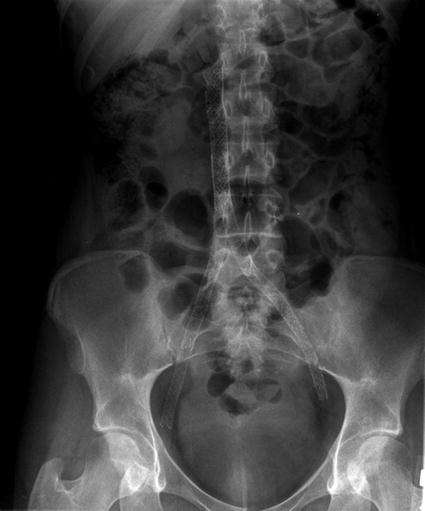Fig. 23.1
Angiograms performed in the right femoral vein (a) and left femoral vein (b) show total occlusion of the common iliac veins bilaterally as well as of the infrarenal inferior vena cava, with numerous venous collaterals seen

Fig. 23.2
Angiograms performed after placement of stents in the right (a) and left (b) external and common iliac veins, showing restored patency of these veins, with very little opacification of the collateral veins

Fig. 23.3
Abdominal x-ray showing the configuration of the stents in the external and common iliac veins bilaterally entering jointly into stents placed in the infrarenal inferior vena cava
23.10 Pitfalls
Pitfalls to be avoided include inadequate preprocedural planning and incomplete understanding of the occlusion and surrounding anatomy. Careful study of noninvasive imaging prior to the procedure is extremely important in this regard. As stated above, balloon angioplasty is contraindicated until there is certainty that the wire has crossed the occlusion and has entered the vascular space on the other side of the occlusion.
23.11 Complications
Complications include subintimal wire passage, which is generally benign, or complete perforation of the vessel wall. As long as no bulky catheters or balloons are advanced across the perforation, bleeding should be negligible. Failure to recognize that the wire is extravascular could result in an uncontrolled tear during angioplasty. Stenting could result in stent malposition or frank embolization. In cases with abundant fresh clot, clot emboli could result in end-organ damage such as pulmonary embolism or stroke. Thrombectomy with AngioJet is well reported to potentially cause hypotension, bradycardia, and even asystole, particularly if close to the heart. Thrombectomy systems that result in significant erythrocyte lysis, such as AngioJet, will also cause hemoglobinuria, which could lead to renal failure. Contrast nephropathy and radiation injury are always potential concerns during long and complex cases such as these.
< div class='tao-gold-member'>
Only gold members can continue reading. Log In or Register to continue
Stay updated, free articles. Join our Telegram channel

Full access? Get Clinical Tree


